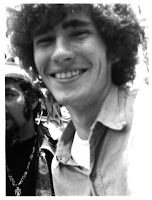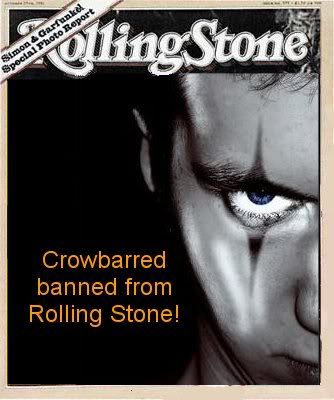Number 508 - Tim Buckley

 Number 508
Number 508Tim Buckley
"Song to Siren"
(1971)
.
.
.
.
Genre:Folk Rock
art by xMDOMMx
 I now know why "proper" writers of websites hate blogs so much. It's not that they hate the bloggers, its because we cheat using already made html assisted programmes. After 1.5 years of doing "Definitive 1000" I thought it would be time for this web page to go out on its own IE: www.crowbarred.com After all, I thought I was at the stage of understand and feeling confident about html, sort of like Neo in "The Matrix" ....."I know kung fu" So yours truly had a bash at writing my very own site and guess what .... yup not only failed but the words you so often see on the net .. Epic Failure. What we do here in blog land and what they do in web html designing are two different worlds. Their world is complex, meticulous, laborious, with eye for detail. They slave over every scripted word, dot & symbol. Sadly, I have found out my world now to be lazy. (but its all I've got .. for now) So its back to school for me, ground floor, wearing a dunce hat for a few months till i nut it out. So be it.
I now know why "proper" writers of websites hate blogs so much. It's not that they hate the bloggers, its because we cheat using already made html assisted programmes. After 1.5 years of doing "Definitive 1000" I thought it would be time for this web page to go out on its own IE: www.crowbarred.com After all, I thought I was at the stage of understand and feeling confident about html, sort of like Neo in "The Matrix" ....."I know kung fu" So yours truly had a bash at writing my very own site and guess what .... yup not only failed but the words you so often see on the net .. Epic Failure. What we do here in blog land and what they do in web html designing are two different worlds. Their world is complex, meticulous, laborious, with eye for detail. They slave over every scripted word, dot & symbol. Sadly, I have found out my world now to be lazy. (but its all I've got .. for now) So its back to school for me, ground floor, wearing a dunce hat for a few months till i nut it out. So be it.Jeff Buckley's music is a personal favourite of mine and listening to his father has the same comparison as a John Lennon & Julian Lennon but it is my view that Jeff was the better singer than his father, but as we all know that was only made possible because of Tim .
14.02.47 to 29.06.75
One of the great rock vocalists of the 1960s, Tim Buckley drew from folk, psychedelic rock, and progressive jazz to create a considerable body of adventurous work in his brief lifetime. His multi-octave range was capable of not just astonishing power, but great emotional expressiveness, swooping from sorrowful tenderness to anguished wailing. His restless quest for new territory worked against him commercially: By the time his fans had hooked into his latest album, he was onto something else entirely, both live and in the studio. In this sense he recalled artists such as Miles Davis and David Bowie, who were so eager to look forward and change that they confused and even angered listeners who wanted more stylistic consistency. However, his eclecticism has also ensured a durable fascination with his work that has engendered a growing posthumous cult for his music, often with listeners who were too young (or not around) to appreciate his music while he was active.
.
 The fragile, melancholic, orchestrated beauty of the material had an innocent quality that was dampened only slightly on the second LP, Goodbye and Hello (1967). Buckley's songs and arrangements became more ambitious and psychedelic, particularly on the lengthy title track. This was also his only album to reach the Top 200, where it only peaked at number 171; Buckley was always an artist who found his primary constituency among the underground, even for his most accessible efforts. His third album, Happy Sad, found him going in a decidedly jazzier direction in both his vocalizing and his instrumentation, introducing congas and vibes. Though it seemed a retreat from commercial considerations at the time, Happy Sad actually concluded the triumvirate of recordings that are judged to be his most accessible.
The fragile, melancholic, orchestrated beauty of the material had an innocent quality that was dampened only slightly on the second LP, Goodbye and Hello (1967). Buckley's songs and arrangements became more ambitious and psychedelic, particularly on the lengthy title track. This was also his only album to reach the Top 200, where it only peaked at number 171; Buckley was always an artist who found his primary constituency among the underground, even for his most accessible efforts. His third album, Happy Sad, found him going in a decidedly jazzier direction in both his vocalizing and his instrumentation, introducing congas and vibes. Though it seemed a retreat from commercial considerations at the time, Happy Sad actually concluded the triumvirate of recordings that are judged to be his most accessible..
 The truth was, by the late '60s Buckley was hardly interested in folk-rock at all. He was more intrigued by jazz; not only soothing modern jazz (as heard on the posthumous release of acoustic 1968 live material, Dream Letter), but also its most avant-garde strains. His songs became much more oblique in structure, and skeletal in lyrics, especially when the partnership with Larry Beckett was ruptured after the latter's induction into the Army. Some of his songs abandoned lyrics almost entirely, treating his voice itself as an instrument, wordlessly contorting, screaming, and moaning, sometimes quite cacophonously. In this context, Lorca was viewed by most fans and critics not just as a shocking departure, but a downright bummer. No longer was Buckley a romantic, melodic poet; he was an experimental artiste who sometimes seemed bent on punishing both himself and his listeners with his wordless shrieks and jarringly dissonant music.
The truth was, by the late '60s Buckley was hardly interested in folk-rock at all. He was more intrigued by jazz; not only soothing modern jazz (as heard on the posthumous release of acoustic 1968 live material, Dream Letter), but also its most avant-garde strains. His songs became much more oblique in structure, and skeletal in lyrics, especially when the partnership with Larry Beckett was ruptured after the latter's induction into the Army. Some of his songs abandoned lyrics almost entirely, treating his voice itself as an instrument, wordlessly contorting, screaming, and moaning, sometimes quite cacophonously. In this context, Lorca was viewed by most fans and critics not just as a shocking departure, but a downright bummer. No longer was Buckley a romantic, melodic poet; he was an experimental artiste who sometimes seemed bent on punishing both himself and his listeners with his wordless shrieks and jarringly dissonant music..
 Almost as if to prove that he was still capable of gentle, uplifting jazzy pop-folk, Buckley issued Blue Afternoon around the same time. Bizarrely, Blue Afternoon and Lorca were issued almost simultaneously, on different labels. While an admirable demonstration of his versatility, it was commercial near-suicide, each album canceling the impact of the other, as well as confusing his remaining fans. Buckley found his best middle ground between accessibility and jazzy improvisation on 1970's Starsailor, which is probably the best showcase of his sheer vocal abilities, although many prefer the more cogent material of his earliest albums.
Almost as if to prove that he was still capable of gentle, uplifting jazzy pop-folk, Buckley issued Blue Afternoon around the same time. Bizarrely, Blue Afternoon and Lorca were issued almost simultaneously, on different labels. While an admirable demonstration of his versatility, it was commercial near-suicide, each album canceling the impact of the other, as well as confusing his remaining fans. Buckley found his best middle ground between accessibility and jazzy improvisation on 1970's Starsailor, which is probably the best showcase of his sheer vocal abilities, although many prefer the more cogent material of his earliest albums..
Buckley's life came to a sudden end in the middle of 1975, when he died of a heroin overdose just after completing a tour. Those close to him insist that he had been clean for some time and lament the loss of an artist who, despite some recent failures, still had much to offer. Buckley's stock began to rise among the rock underground after the Cocteau Twins covered his "Song for the Siren" in the 1980s. The posthumous releases of two late-'60s live sets (Dream Letter and Live at the Troubadour 1969) in the early '90s also boosted his profile, as well as unveiling some interesting previously unreleased compositions. His son Jeff Buckley went on to mount a musical career as well before his own tragic death in 1997. ~ [Richie Unterberger, All Music Guide]
For John Lennon see Number 639
For Julian Lennon see Number 798  What does Rolling Stone think of Tim Buckley?
What does Rolling Stone think of Tim Buckley?
For David Bowie see Number 634 & #513
 What does Rolling Stone think of Tim Buckley?
What does Rolling Stone think of Tim Buckley? When he died in 1975 of a heroin overdose, Tim Buckley left behind nine albums in nine years, all of them commercial duds. Yet it's possible to trace a straight line from Buckley's soul-excavating excursions through the work of Patti Smith, U2, Radiohead and his own estranged son, the late Jeff Buckley. Tim Buckley's best-known ballad was "Song to the Siren," and that haunted masterpiece alone justifies the existence of Morning Glory: The Tim Buckley Anthology, though "Siren" was hardly typical of his career. If anything, this two-disc retrospective makes apparent why Buckley had such a tough time selling records: Each album brought a new sound, and the singer never quite figured out the difference between artistic daring and overblown self-indulgence. In his early songs, Buckley suggested an Elizabethan troubadour straitjacketed by overly formal lyrics, but with 1967's "Pleasant Street," an anguished aggression took hold. Soon this prim California folkie began to experiment with atmospheric jazz voicings in a way that rivaled Van Morrison's Astral Weeks. Buckley is at his most riveting in less grandiose settings; live versions of "I've Been Out Walking" and "Troubadour" showcase the joyous elasticity of his four-octave range. He experimented to the end, sometimes brilliantly (the Yoko Ono-like screamfest "Monterey"), sometimes to his enduring embarrassment (the Rocky Horror-esque S&M of "Make It Right"), but always with a consequences-be-damned conviction. [Source: RS 865 GREG KOT]
For U2 see Number 661
Rolling Stone Top 500 Songs ranked this song at Number (Not our problem) and the Album ranked at Number (cos we still can)
This song has a crowbarred rating of 75 out of 108



This Mortal Coil version
Click play to hear the rest of the album
Tags:Tim Buckley, 1971, Folk Rock, John Lennon, Van Morrison, Julian Lennon, Jeff Buckley, U2, YouTube, Music Video, Rolling Stone Magazine, Crowbarred, New Zealand, Crowbarred Unleashed, The Definitive 1000 Songs Of All Time, Mellow Mix Volume 1, Mellow Mix Volume 2, Mellow Mix Volume 3
By The Year 1955 to 2005:
1955, 1956, 1957, 1958, 1959, 1960, 1961, 1962, 1963, 1964, 1965, 1966, 1967, 1968, 1969, 1970, 1971, 1972, 1973, 1974, 1975, 1976, 1977, 1978, 1979, 1980, 1981, 1982, 1983, 1984, 1985, 1986, 1987, 1988, 1989, 1990, 1991, 1992, 1993, 1994, 1995, 1996, 1997, 1998, 1999, 2000, 2001, 2002, 2003, 2004, 2005

underlay crowbarred trademe
Labels: Tim Buckley


















0 Comments:
Post a Comment
<< Home